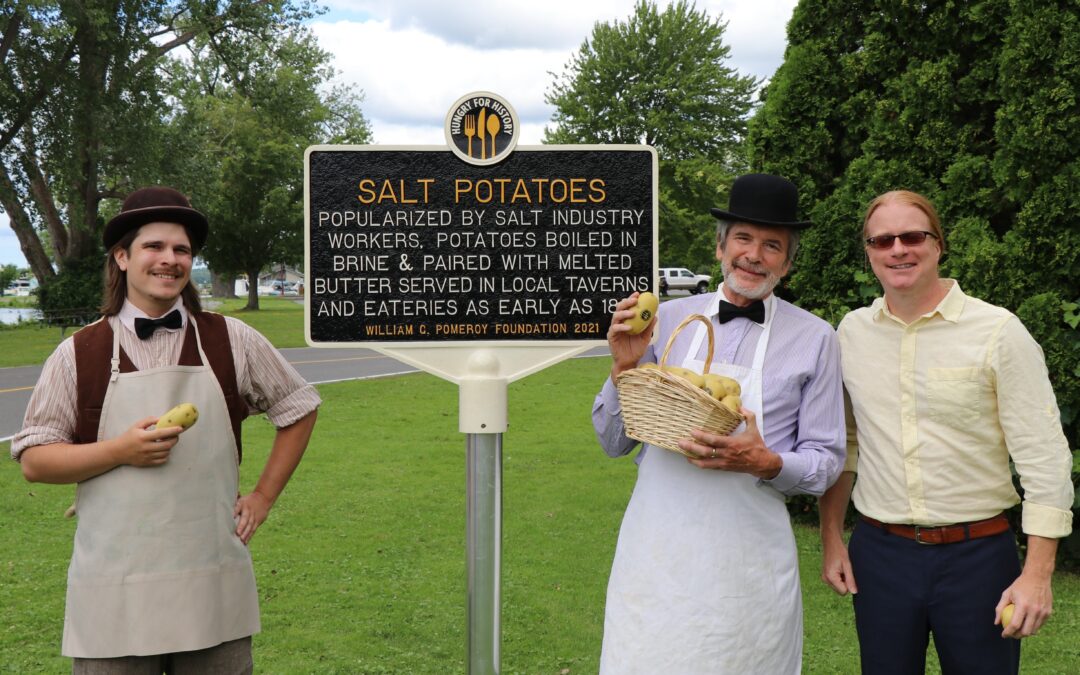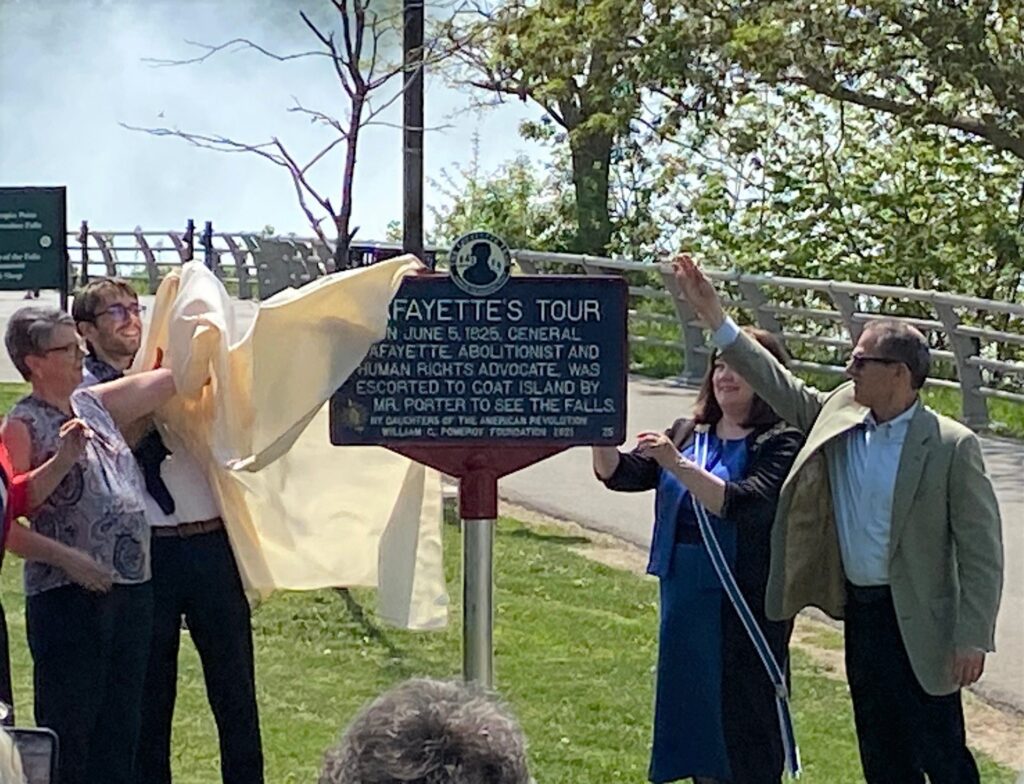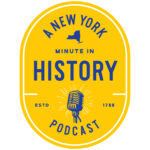
On this episode, Devin and Lauren tackle all of New York’s historical markers at once — sort of. Devin and Lauren discuss how the state’s historical marker program got started, what happened to it, and how communities can apply for a marker today. As an added bonus, Devin and Lauren speak with Susan Hughes of the William G. Pomeroy Foundation about the foundation’s new “Hungry for History” grant program — and they also speak with Bill Pomeroy himself, about his interest in history and some of his favorite markers.
Guests: William G. Pomeroy, founder and trustee of the William G. Pomeroy Foundation; Susan Hughes, historian and archivist for the William G. Pomeroy Foundation
A New York Minute In History is a production of the New York State Museum, WAMC, and Archivist Media, with support from the William G. Pomeroy Foundation. This episode was produced by Jesse King. Our theme is “Begrudge” by Darby.
Further Reading:
Apply for a New York State Pomeroy Marker
New York State Museum history of the State Marker program
Teacher Resources:
Stop the Drive-Bys: A Teacher Makes the Case for Local Historical Markers, American Association for State and Local History.
Not Your Usual History Lesson: Writing Historical Markers, National Council of Teachers of English
Follow Along
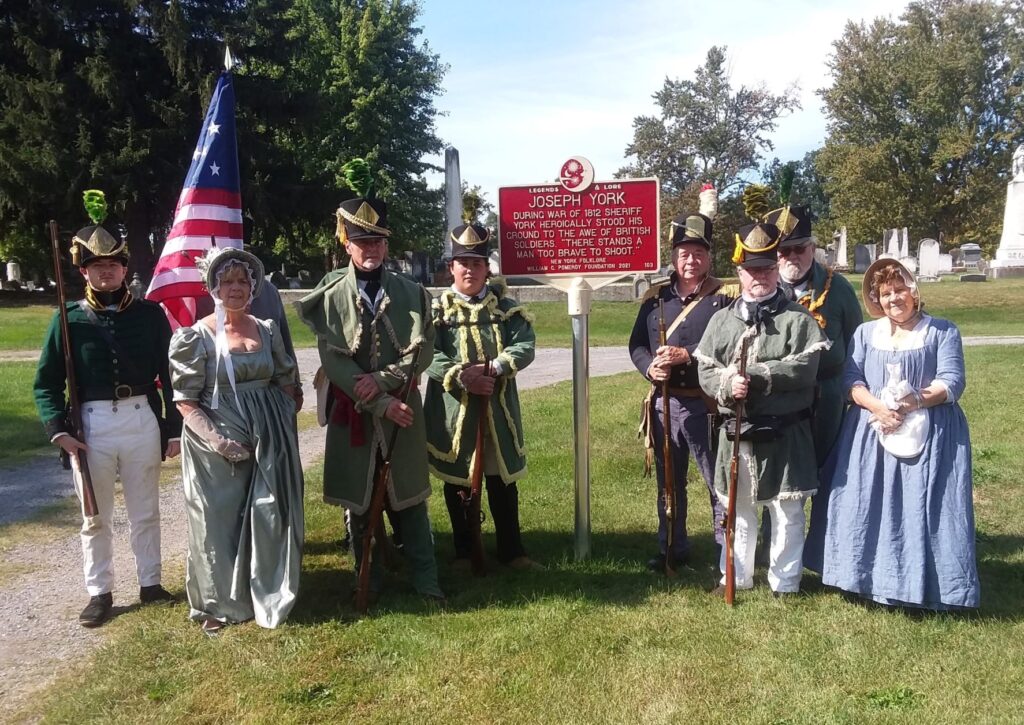
Devin: Welcome to A New York Minute in History. I’m Devin Lander, the New York state historian.
Lauren: And I’m Lauren Roberts, the historian for Saratoga County. This month, we are departing from our regular format of focusing on a single William G. Pomeroy-funded historic marker, and instead, we’re going to talk about all New York state historic markers – generally speaking. Now, the Pomeroy Foundation has been funding markers since 2006, but we all know that those recognizable blue-and-yellow historic markers have been around a lot longer than that. We’re going to discuss when and why that original marker program started, and what became of it.
And also, maybe after listening to some of our previous episodes, you might be thinking about the history in your own community, and are considering applying for a William G. Pomeroy historic marker. And maybe you have some questions about what that process looks like. So we’re going to talk to Susan Hughes, who’s the historian and archivist for the Pomeroy Foundation, who will walk us through the application process and answer our questions. And as an added bonus, we get to speak directly with Bill Pomeroy himself about the creation of his amazing foundation, how his interest in New York state history came about, and even find out what his favorite historic marker is.
So Devin, as New York State historian, you’ve got access to the records in the archives of how the New York state historic marker program started. Can you tell us a little bit about how that program came to be?
Devin: Absolutely. And it’s really an interesting story, as we are transitioning and planning at the state level – and at I know you are in the county as well – for the 250th commemoration of the American Revolution. It really gave us the opportunity to look into some of our records, specifically the records of the 150th anniversary, which took place in 1926. And the New York State Archives has an extensive collection of material from that era, and from that commission that was formed, and one of the initiatives that came out of that was this historic marker program. And it really had its genesis in the granite-and-bronze markers that were designated for sites related directly to the American Revolution. So Saratoga Battlefield has one, there’s one at Bellcore Island, there’s others around the state. They also talked about markers that would commemorate historically significant sites, or people or events, that took place outside of the Revolution. And that’s where the idea for the blue-and-gold markers really came about. You started to see the production of these in 1926. And it really lasted until about 1939, when the program was defunded.
And they did hundreds of them around the state. The process was that municipalities, or even individuals, could apply for a marker. They would send in a letter to the state historian and the Office of State History, suggesting the topic, maybe suggesting some material, although the primary source material wasn’t as robust as we would expect today, and as the Pomeroy Foundation expects today. But there was the requirement of at least some background information – you know, did this event really happen? Were these people really there? That type of thing. The Office of State History and the state historian, who oversaw it at the time, went and made the decision as to whether or not the marker would go forward. And the majority of these, I don’t know if it’s 100 percent of them, but the majority of these were given to the municipality, for a cost, sometimes as low as $2. And a marker could be erected from there on out.
Like I said, 1926-1939, they erected hundreds of these. It became, I would say, arguably the most popular public history program of its time. Other states emulated what New York was doing. And then the program went away. We have to think 1939, why did they defund it? We don’t really know. The Legislature just stopped putting money in for this program. Then by 1960, a new program came forward. And this was a partnership between the Thruway Authority and the State Education Department and the state historian at the time, the Office of State History. This resulted in the large cast-iron signs and markers that you see mostly at the Thruway rest stops. Really by the 1970s, that program ended. And the state itself has not been in the business of erecting markers on a consistent basis from then on.
There has been some erected by various commissions over the years, but the majority of any markers that you see, from say, 1972, till 2006, when the Pomeroy Foundation becomes involved – those markers were erected sometimes by local historical societies. Sometimes the town or municipality itself would erect a marker. And these were not vetted by the state, and the state historian’s office didn’t have anything to do with them.
Lauren: I think one of the important things to know is that the state signs are usually labeled at the bottom of the sign as “State Education Department.” So one of the ways to tell who erected the sign is to look at the bottom of the sign and see what we would call the “credit line.”
Devin: One of the ways that we identify markers, whenever one topples or is somehow taken down, is exactly that, Lauren: who erected the marker. And that will be stamped towards the bottom of the sign.
Lauren: When a sign does fall, since the state education program no longer exists, those signs that were erected by SED fall under the jurisdiction of the municipality in which they’re located. So if you have a marker in your village, and it gets hit by a car, or it gets pushed over by a snow plow, it is under the jurisdiction of the municipality to do maintenance, or fix it, replace it.
Devin: Interestingly, though, I do get contacted often about projects related to refurbishing an original marker, or if a marker becomes damaged. Sometimes a local organization, or even a Boy Scout or somebody like that, will take on the project of refurbishing. And we do have guidelines on our website as to how to do that – exactly what colors are used for the blue and gold. That information is on the Office of State History website. But yes, the markers are the responsibility of the municipality.
So Lauren, as a county historian who has worked not only with the Pomeroy Foundation, but has also worked with other organizations in erecting historic markers, I would like to know what your thoughts are about the markers themselves. What do markers represent?
Lauren: There are a lot of benefits to putting up historic markers. I think when you boil it down, historic markers tell people that something important to the community’s history happened here. It gives a concrete location where people can go and plant their feet and recognize that this destination is important to the story of that place. And I think having signs in public places…it allows you to get your story out to a larger audience than you would at, let’s say, a single presentation, or maybe writing an article to your local newspaper. Those things are good too, but I think having signs in a public place allows you to reach more people.
Another benefit to putting up historic markers is that you’re using bite-sized chunks of history. We want information that can fit on the screen of our phone. The William G. Pomeroy Foundation, they have guidelines that you have to follow: the top line, the title line, you only get 15 characters, and that includes punctuation and spaces. And then you get five lines of text with 27 characters each. So it’s not a lot of real estate. You really have to concentrate on the most important parts of the story, and those pieces that will make people invested in learning more.
Devin: In a way, historic markers are teasers to try to get them not only to research more and to maybe look into it if they want to learn more, but also give them a sense that “history happened here.” Of course, there’s a downside to historic markers, as with any kind of memorial or monument – it’s a snapshot in time. Once they’re up, it’s hard to alter. And I know with some of the original historic markers that the state erected, we’ve come to see them in a different light. They use terminology that we wouldn’t use today. Sometimes the history is not exactly 100 percent accurate. Because history is an evolving field – it’s not just the facts, as many people think it might be, it’s actually interpreting events of the past – a historic marker can very much be accurate in the time in which it was erected, but new understanding comes to light, new material in the archives comes to light, and we realize that, in fact, the story’s more complex. Or, in some cases, the story is not true. So you know, I think that should be taken into account with historic markers.
I know the Pomeroy Foundation has an advantage, being online, because they can make changes, at least on the website. But they also have a very rigorous process to vetting these markers, more so than the original markers, which Susan will tell us about.
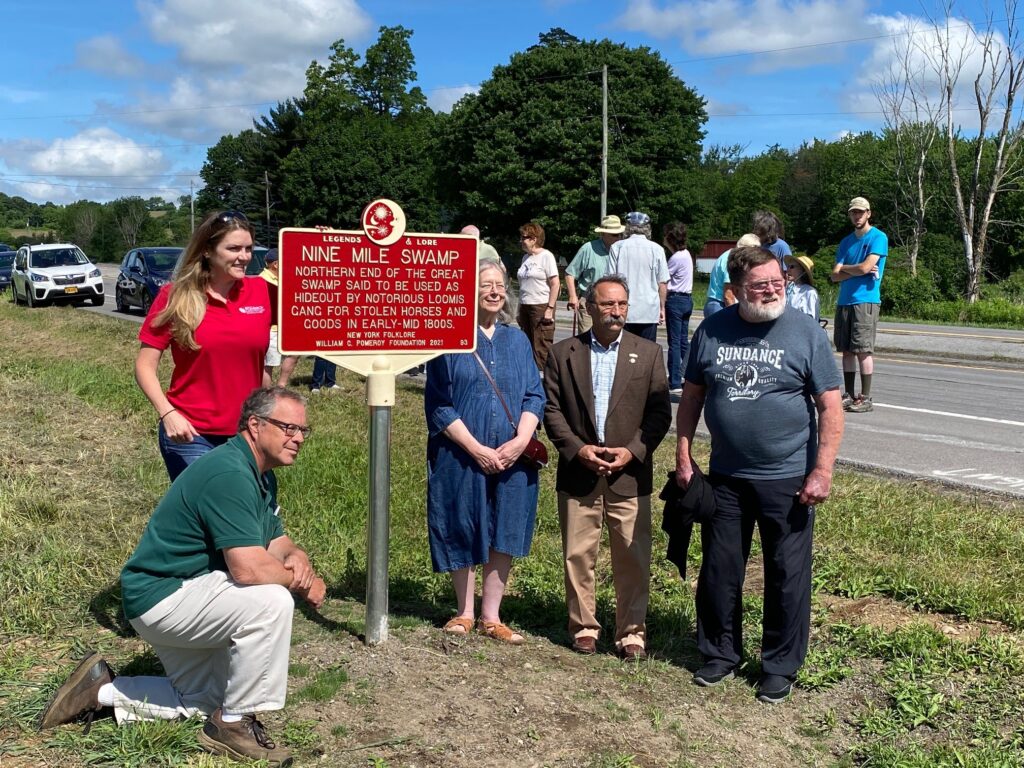
Susan: For the State Historic markers, those traditional blue-and-yellow markers, we have different grant rounds, four grant rounds a year. And it really depends upon what county you want to place the marker in. The other programs we have, say, “Legends and Lore,” and our newest one, “Hungry for History,” they have their own deadlines. With those we usually have twice a year.
Our application process starts with what we call an LOI, which is basically a letter of intent. You’re giving us a proposed inscription for the marker, and then a list of the primary sources that you intend on submitting. We don’t need the actual primary sources at that point. And you send that into us, and we will evaluate that. We make sure that what you want to apply for actually qualifies for the guidelines for that program. We’ll also look over what you intend to send us in terms of primary sources, and let you know if we see something that needs to be added to that, or if something is not acceptable, or sometimes people just overlook a certain fact that they want to put on the marker.
So we send that back, and that gives you plenty of time to gather the things that you need for your application. And then you go back on the website, and everything is done online. And that’s the point where you decide on what exactly you want the marker to say. You do need to have a land permission letter signed by the owner of the property where you intend to put the marker. And really one of the most important things is supporting primary sources.
Lauren: Why is it that the primary sources are so important for the text on these markers?
Susan: Primary sources are usually what we say is the least filtered source of data. They are the things that were created typically at the time of the event, or they are information that’s based on first-hand knowledge. With secondary sources, with historical compilation history books, local history books, encyclopedias, Wikipedia – you know, every time someone tells a story, details can get dropped, there’s changes of emphasis, and sometimes, inadvertently, errors get introduced. And even if it’s a textbook, sometimes they can create a little bit of crater bias based on the purpose and the point of view of the creator. I know a lot of us have those county history books in our libraries and in our collections that were done, say between, you know, the late 1860s and the turn of the last century. We get a lot of people submitting those, saying, “It was written about my county and the person was alive at the time.” But the problem is, it is a compilation. And a lot of times the information that it contains, you know, you’re submitting something that was published in 1888 to support something that happened in 1768. That book is not considered a first-hand record, and it’s not really based on first-hand knowledge. So then we tell people that you need to go find the records that that person used to write that book, because what we’re looking for is facts, not someone’s analysis of what happened.
A lot of times we feel, well, if it’s in a textbook, and it’s published in a book, it must be true. Most of us know, especially historians, that that’s not necessarily so, because not all publishers are fact checking what’s in a book, either now or back in the 1880s.
Devin: The Pomeroy foundation is continuing to create new marker programs. Can you tell us a little bit about the new “Hungry for History” program?
Susan: This is a really interesting one, and we’re really excited about this. It’s designed to celebrate America’s food history. What we’re looking for is local and regional specialties that helps sort of form community identity. The first marker we put up was for salt potatoes. It’s at Onondaga Lake Park near the Salt Museum. It’s really a food that is identified with Syracuse. Basically, we’re looking for prepared dishes of two or more ingredients, and we’re looking to commemorate the food dish itself, so not food-related events. We’re looking for things that are still eaten today, even if they are in some different variation. We don’t do condiments, and we don’t do any brand names. So for example, supposedly the Nestle’s Crunch bar was made only in the old Nestle factory in Fulton, New York. That would be a brand name, we would not do that.
Lauren: If you could give some advice to somebody who’s never applied to one of your markers, what would you tell them?
Susan: The big thing I would say is do your homework. Read the criteria closely. Look at the FAQ page on the website. We have a lot of information on our website as to exactly what we accept. We have webinars that they can watch for free. You’re welcome to call us if you don’t see an answer to your question. And one of the things I do want to say, is that if you apply for a marker, and you’re not able to find all the primary sources you need, or you have some kind of difficulty with the application, you’re always welcome to let us know that you’d like to close out the application, and you can come back and reapply the next round. We are not a one-and-done type of foundation.
Lauren: Devin, you were mentioning before that some of the markers that were placed quite a while ago, their terminology is what we see now as insensitive or maybe even offensive. And sometimes the stories are completely inaccurate. And I know that we have some of these in Saratoga County, where names are misspelled on the state historic markers. Do you have some thoughts on how to deal with those inaccuracies, misspellings, that kind of thing?
Devin: One of the ways, when we talk about terminology and the changing perceptions, is to understand that many of the original historic markers, or all of the original historic markers, really come from one perspective, right? There weren’t a lot of signs that were erected for underrepresented communities, including people of color, the indigenous community, women – there wasn’t a lot of markers devoted to women, either. You know, that’s one of the things I think that the Pomeroy Foundation is doing really good, is trying to be more inclusive of the topics that they touch on, the communities that are not represented currently in the history. And making sure that the material is vetted by experts in a community’s history, whomever that may be. I think it’s vitally important to make sure, again, you can’t guarantee that perspectives won’t change in the future, but doing a better job of being more inclusive to these stories and to the communities themselves.
The other way to look at it is, if there’s a historic inaccuracy on a marker or a misspelled name, it may not be an option to take the marker down and change it – especially an original SED marker, which again, we don’t make those anymore. So it may be a good idea, if it’s in a location that would warrant this, and if the community feels it’s important enough to make note of the inaccuracy with another marker or an interpretive sign of some kind. That’s an option for monuments and for other things that are larger and more permanent and more difficult to change. But even a historic marker, if there’s an inaccuracy or a misspelling, making an interpretive marker or sign next to the marker saying, “Hey, look, this is actually spelled wrong,” or, “Hey, look, new information has come to light, and this is an inaccurate statement.” The real successful markers leave the reader, again, with a taste of the history that they want to learn more about.
Lauren: One of the things that I think historians and people who are interested in local history/state history have in common is that they love road trips, right? I mean, I’m sure we can all think of times that we went on road trips, and we found these cool side-of-the-road places, whether it’s a historical society or a lock on an old canal. And you discover these things that you had no idea happened in your backyard or maybe across the country. I can’t bear to drive by one of those places without stopping, to the annoyance of the rest of my family. But that’s just the way it is. And when we talked to Bill Pomeroy, road trips are one of the things that he said was important in developing his love of local and New York state history.
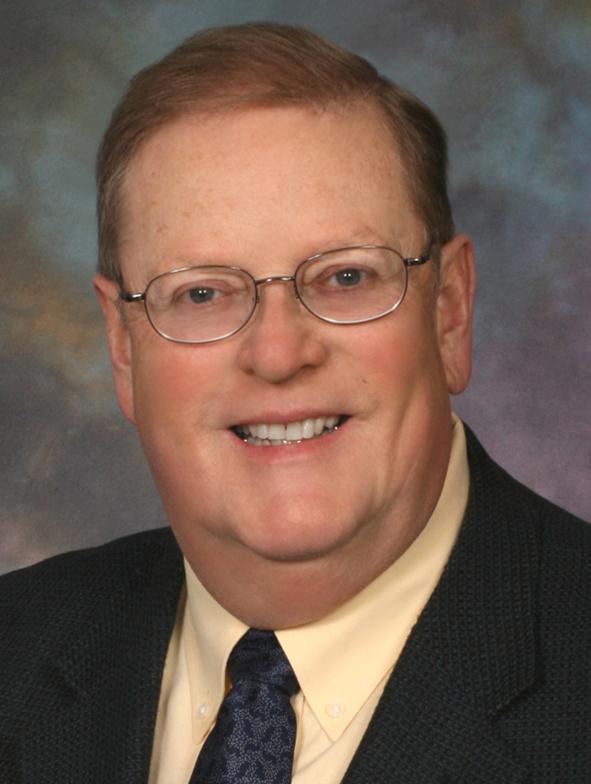
Bill: When I was a boy, my dad, he was a traveling salesman and manufacturer’s representative, and I used to go along with him for the ride. He had a 1950 Chrysler Windsor – and he was interested in history too, and he knew that I was, so we’d pull over at every single roadside marker we saw. We’d read these markers together, and that became just a feature of what we did.
A couple of college degrees later, and a camping trip around Europe, I became a marketing rep for IBM, selling mainframe computers in Silicon Valley. After IBM, my wife and I spent over a year living in a Volkswagen camper in Mexico, Central America, and all the way down into South America. I had learned so little of that area’s history in school, and the history is just unbelievable. On that trip, we traveled over 50,000 miles. So that’s what I returned to New York, and when I uncovered some unknown direct ancestors, specifically Spencer Pomeroy, my third great-grandfather, you know, with his sisters, his mother, his family, his two children that were born there – he settled here in Pompey over 200 years ago, less than six miles from where I live today. I was dumbfounded. I’m fascinated with New York state history and my own family’s history here in New York.
Devin: When did you make the decision to go with a marker program and just how did that evolve?
Bill: The historic marker program idea came about somewhat by accident. We did a project with the Pompey Historic Society and the highway department over there to refurbish the town’s nearly unreadable roadside markers. They worked out very well. It had strong community interest, and involvement with a lot of volunteers. And once they were reinstalled and back in place, and the community was so proud of their nicely repainted markers, it just opened my eyes to how interested the community was in these markers – it wasn’t just historic buffs, like me. So it was a lot of fun. We decided, well, let’s put up some new ones. And let’s start funding some historic markers here in Onondaga County. Around 2010, we expanded the program to all the counties surrounding Onondaga, and by 2012, we took the program statewide. And I gotta tell you, that demand for historic markers far exceeded our expectations. The foundation has funded more than 1,500 markers and plaques nationwide, including all the way up to Alaska. We have yet to get one in Hawaii.
Devin: Your foundation has a motto that says, “For history and for life.” Can you tell us a little bit about the great work your foundation does in the battle against blood cancer?
Bill: Oh, sure. I survived a very serious case of leukemia, it was called AML. I survived because I had a bone marrow transplant from a stranger who perfectly matched as a donor for me. And I didn’t realize that at the time, I thought that was pretty normal, but I learned later that there’s a lot of people that go searching for a match on the registry, and they can’t find any kind of match. And if that had happened to me, I wouldn’t be here talking to you today. And so in 2008, we committed to diversifying the Be The Match registry. And this is the largest bone marrow registry, because we wanted anyone from any ethnic background to be able to find a lifesaving match. Since 2008, we’ve helped organize hundreds of bone marrow drives. We’ve registered more than 26,000 people to the registry, and we know that it’s resulted in at least 107 donor patient matches.
Lauren: So we can’t close out the interview without asking an important question. I would be remiss if I didn’t ask you if you had a favorite marker.
Bill: My roots are in Pompey, and that’s really where everything started. For me, my family was there, we did our first involvement with historic markers there – and there’s two [markers] that we placed that I kind of liked over there, and the one was the Revolutionary War veteran Conrad Bush, who is reported to be the only Revolutionary War veteran that was granted a 600-acre military tract that actually settled on his land. Also in Pompey, we have the honor of being the birthplace of a New York state governor, Horatio Seymour, who lived from 1810 to 1816 and was a contemporary of my family. You know, there’s a lot more that are funny, strange, surprising – just to encourage the listeners that if you want to find these markers, and all the rest of the markers that we have, we have an interactive map on our website, wgpfoundation.org.
Lauren: Alright, Devin.
Devin: Are you asking me?
Lauren: I’m asking you. What’s your favorite historic marker?
Devin: I guess I would say it’s a new marker that was erected this year in the town of North Cohocton, which is in Steuben County, right up the road from where I grew up in the town of Wayland. And it reads: “Wetmore Brothers General Store. Built in 1873 by Nelson A. Wetmore, owned by Wolfanger and Pierce 1898-1923, later named Wolfanger Store, renovated and reopened in 2015.” This is called “the old country store” where I grew up. Again, it’s about five miles from my parents house. And we used to go there when I was a kid, before it was renovated. It was still in operation, and you could buy penny candy and ice cream and things like that. And I can remember as a child, driving by it and always asking, “Can we stop the old country store?” And to see that the Pomeroy Foundation has erected a marker there, you know makes me very happy. And also to see that it’s been renovated and it’s reopened – this is a very small town – is very interesting to me, and makes me feel good.
Lauren: I think I would also have to pick one from my hometown. It’s actually from the town of Edinburg, where I live now, but I actually grew up in the next town over, and I remember seeing this sign when I was younger. It’s at the foot of the Batchellerville Bridge, which spans the Great Sacandaga Lake, which was a manmade lake that was created in 1930. And this sign commemorates the making of the lake, but it also notes the loss of the communities that were flooded out in order for the reservoir to be created. They had to hold back the water to stop the downstream flooding of the Hudson River. At the time in 1930, it was a very controversial project, because the people who lived in those communities were basically being forced out by the state for the public good. The project was touted as being for the “public good” because it was benefiting downstream communities – and also it really was an engineering feat. It was a pretty amazing project for the amount of time they spent on it, the amount of land that they had to clear, bridges that they had to build, new roads that went in, and of course, the Conklingville Dam. So it’s one that I have seen now that actually commemorates the creation of the reservoir while also remembering the communities that were lost. So I’d have to say that’s one that’s pretty special to me.
While no marker or monument is perfect, the benefits of erecting historic markers outweigh their limitations. We can’t predict the ways in which the future will interpret history, but by making accuracy the utmost priority, we can use these markers as a tool in telling the history of our communities. These signs create pride of place among the residents, attract the interest and economic benefits of heritage tourism, and reach a wider audience than other methods of interpreting local history.
Devin: Thank you for listening to A New York Minute in History. This podcast is a production of WAMC Northeast Public Radio, the New York State Museum and Archivist Media. A special thank you to Bill Pomeroy and Susan Hughes from the William G. Pomeroy Foundation, which supports this podcast. Our producer is Jesse King. I’m Devin Lander.
Lauren: And I’m Lauren Roberts. Until next time, Excelsior.
